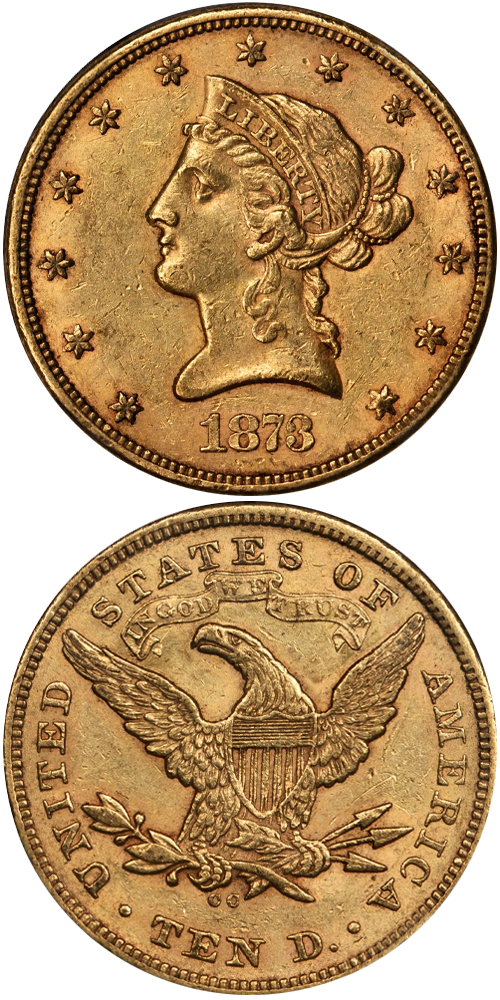1873-CC Liberty Head Eagle
Jeff Ambio: This obverse die is readily identifiable by repunching at the bases of the digits 1 and 8 in the date, although one will almost certainly need a loupe to distinguish this feature. The reverse is a reuse of that which the Mint used to strike some 1870-CC and 1872-CC eagles, as well as all of those dated 1871-CC. The mintmark is small, round and set high in the field entirely to the left of the lowermost arrow feather. Both of the Cs in the mintmark are level. Die State I of this variety does not display shelf doubling on the peripheral lettering on the reverse.
Rusty Goe: Of the millions of dollars of bullion that mining companies deposited at the Mint, the largest percentage of it was converted not into coins but into bars. Treasury Department statistics show that in 1873 the production of bars, in terms of aggregate face value, in all three classes, exceeded that of coinage output at the Carson Mint by a ratio of over ten to one. The face value of fine gold bars produced that year had increased to over six figures, compared with the $2,000 the mint's assayers had stamped in 1871. The two unparted bar categories combined to ascend to near the $8.5 million level.
Coiner Chauncey Noteware delivered 1,040 eagles in early 1873. The Carson Daily Appeal of June 12, 1873, reported that Noteware had struck 3,000 $10 gold pieces over a two-day period, "the bullion having been obtained from scraps, clippings and general salvage from waste." He must not have delivered that "scrappy" run before the end of June, however, because in official Bureau of the Mint records they show up in the ledger for coins produced in the second half of 1873. By then, a new coiner, William "Hy" Doane, who had replaced Noteware on July 1, had taken charge of the press. He added another 503 eagles, perhaps made from more salvaged gold clippings, to that year's output.
The 4,543 eagles delivered in Carson City in 1873 represent the fourth-lowest mintage figure for that denomination in the institution's history. A meager amount for sure, but still more than five and a half times the Philadelphia Mint's output in 1873 -- the San Francisco branch delivered 12,000 eagles.
Q. David Bowers: I estimate that 50 or so 1873-CC eagles exist today, not a single one of which has touched the Mint State level. In 2003 Rusty Goe found that the highest certified example was a solitary AU-55 by NGC. The scenario of earlier years is repeated -- at the time of issue these went into circulation in the American West and saw extensive use.
The grading of coins is interesting to contemplate, as it has been for years. In March 1911 Thomas L. Elder auctioned the gold coin collection of William H. Woodin, including the $10 denomination. Included was Lot 1341: "1873-CC About Fine; scarce." In November 1939 B. Max Mehl reoffered it as Lot 1726 in his sale of the William B. Hale Collection: "1873-CC Very Fine. Quite rare. From the famous Woodin Sale in 1911."
The example to the left was sold by Stack's Bowers Galleries in the August 2012 Battle Born Collection of Carson City Coinage, where it realized $94,000.






